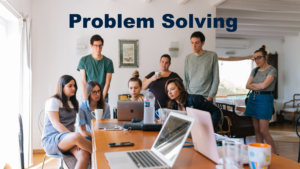One of the issues that is most concerning leadership teams at the moment is how they can maintain their organisational culture with a hybrid working model. How do you build cohesion when your people are working from home 2 or 3 days a week and when some colleagues may only rarely meet each other face-to-face? Here are our recommendations.
1. Work out what really binds your organisation together
It is easy to assume that organisations are united around a shared mission or a shared set of values. Many organisations’ websites have impressive mission statements and sets of values. But in reality an organisation is a community, and what actually brings a community together may be very mundane – for example a shared outlook on life, similar work backgrounds or just a shared sense of humour.
It is important to understand what binds people together in your particular organisation. What drives the management team may not be what gives other employees a sense of belonging or what underlies the sense of community in the staff room.
Gaining a clear view of what drives the sense of belonging and community amongst your staff is key to maintain your culture through a period of remote or of hybrid working. You need to find ways to nurture and reinforce these factors.
2. Make events more inclusive
We all know that shared experiences such as social events can be powerful forces in bringing people together. To make maximum use of these to maintain and develop your culture you obviously need to make people feel more included in organisational events. There are three elements to this: weeding out events that exclude people, broadening participation in events and deepening participation.
Previously, events like the company golf day could be seen as exclusive. If you did not fit in or if you simply had other commitments, then you did not go. If you did not go then then you just missed out – while those who were there would bond over stories of their exploits on that day, no doubt being perceived as those who would “go places” in the organisation because of their sociability and soft skills.
These days, that might well cause resentment – if it did not already. It would certainly be tone deaf in many organisations these days unless it were a very inclusive event. It might therefore be best to put the company golf day and similar exclusive events to one side for a year or two.
Clearly it is important to ensure that more people can attend events. But you also want people fully present and fully participating, even when they are participating remotely. Someone who is half paying attention to an event while answering emails is not engaged either intellectually or emotionally.
One way to improve engagement is to introduce a “real world” element into the experience. Some organisations have meals or a small gift delivered to people’s homes and then share the enjoyment of the meal or gift over Zoom. There is an added benefit that receiving a meal, a gift or a care package at home seems more personal than just getting a freebie at work. That in turn leads to a deeper connection between the individual and the organisation.
Another way is to share an activity. Zoom quizzes have become a cliché of lockdown but they are effective at achieving high levels of participation. Although choirs can be difficult to coordinate online they have a trio of benefits. As well as encouraging participation they also foster teamwork and they get people looking forward to the time when they can sing together in person again.
3. Work with Zoom, not against it
Zoom does some things well and is limited in other respects. Work with the advantages and minimise the disadvantages.
Zoom brings you into people’s homes – somewhere colleagues had rarely seen before lockdown. There is a fine line between being slightly more personal than you would normally be at work and outright intrusion, but the Zoom format can be used to get people to share a little bit more of their home and personal lives than they normally would at work. Over the past year colleagues have met young children on screen, have heard the story behind that picture in the background and have heard a little bit more about people’s home routines, whether that is an early morning work out or a schedule built around the need to collect the children from school.
That slightly increased level of intimacy and personal connection can be used to make relationships with colleagues (and thus with the organisation itself) a little bit deeper. People who have shared personal details, and perhaps even felt a little bit vulnerable at times, will be closer.
Zoom is also a very good tool for one-to-many communication. It works well for well-moderated discussions. It therefore lends itself to people sharing their experiences or expertise with a large group of people and for moderated Q and A sessions. It can often be easier to get a large group of people together on Zoom than it is in the office. It can therefore be easier to get colleagues to share their expertise and experience across the organisation. This can be used to break down silos and to foster greater understanding and coordination across the organisation.
As already noted, Zoom is good for moderated sessions but not good for a chaotic free-for-all discussion. That can be used to run meetings a bit differently. If an effective chairperson moderates a discussion well and people speak by invitation rather than by jumping in, then participants will use their time wisely by giving a more concise, well structured argument and voices that are rarely heard will be heard. The result can be a broader, more considered discussion.
4. Invent new landmarks
Many organisations have emblematic events or ceremonies that punctuate careers and that mark the cycles of working life. These may include the publication of results, Board meetings, the legendary annual Christmas/Eid/Summer party or even just Friday pizza.
In a hybrid work mode some of these milestones may lose their significance. Those working remotely may feel less involved and these milestones may just seem less important when work life and home life are intertwined.
It would be useful to review the roster of events that are celebrated to ensure that they are still relevant to most people within the organisation – and to the organisation itself. It may be that while people’s work and home lives are more closely aligned it may seem more appropriate to celebrate more personal milestones and achievements (such as major birthdays or non-work or family achievements) and to allow the whole organisation to share in these.
At the same time, events can still play an important role in reinforcing the key objectives of the organisation, such as financial results for a commercial organisation. The way these events are marked can be reviewed, however, to make them more inclusive and to make people feel a greater connection to the event being marked. Emotional buy-in to the event builds emotional buy-in to the organisation.
5. Make remote working a shared experience
We know that shared experiences bring people together. We are all struggling with remote working, with each organisation doing it in its own slightly different way. Although we are mostly dealing with the challenges of remote working on our own, this struggle is, in fact, an experience that we all share.
Organisations can make use of this by encouraging people to share their experiences – particularly frustrations, light-hearted moments when everything went wrong and any ingenious hacks that people have come up with to deal with common problems.
Leaders can also use this as an opportunity to show vulnerability by recounting their own struggles with technology.
Remote working has changed the way we work forever. That means that the way that organisations function has changed. We now interact differently at work. In particular, the distinction between work and home life has blurred. Organisations can embrace these changes to ensure that employees remain engaged and that their cultures remain strong.
Strong organisational cultures, in turn, make for flexible, adaptable and resilient organisations with an engaged workforce.



